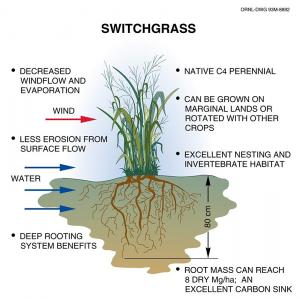Farm-Related Local Environmental Benefits

The environmental benefits of a large-scale commercial switchgrass-fueled energy project will be distributed across the land, air and water of Southern Iowa. The full range of environmental benefits the project will provide include:
- Improved soil stability and reduced soil erosion
- Reduced sediment and chemical run-off into surface lakes and streams
- Improved wildlife and avian habitat
- Improved carbon sequestration in farm soils
- Reduced sulfur, particulate, and net greenhouse gas emissions from host power plant
For more details on the research and results from the project’s agricultural research activities, please see the reports and presentations in the Technical Information – Agricultural Information section of this site.
In 2000, GIS analysis determined that converting 53,649 acres to switchgrass production could reduce annual soil erosion by nearly 95% (from 390,049 to 17,746 tons/year). Research also found that more stable aggregates (mixture/cluster) indicated better soil quality and established switchgrass has about 75% stable aggregates whereas row crop fields have about 34%. Research using the Soil and Water Assessment Tool (SWAT) in 2001 found that the switchgrass scenario reduced sediment yield by 55% relative to the baseline condition. Switchgrass produced average sediment yields a magnitude less than land in row crop production.
Rathbun Lake provides water to more than 60,000 residents in 18 counties. Its watershed consists of around 354,000 acres, where 60% of the land is used for row crop production, 25% is used for pasture and hayland, and one-third is highly erodible cropland, nearly half of which is enrolled in the Conservation Reserve Program (CRP). The lake has been contaminated by agricultural non-point source pollution due to soil loss from highly erodible land; sediment containing farm chemicals is filling the lake three times faster than originally anticipated. Large-scale switchgrass production would impact three of the major sources of water quality impairment currently threatening the lake:
- Sediment and chemicals from cropland - annual erosion on the highly erodible cropland can exceed 30 tons per acre; the problem is likely to worsen as CRP acres are returned to row crop production
- Gully erosion - a source of soil loss on 21,000 acres of land; nearly 90% of sediment from gully erosion reaches the lake
- Soil loss from pasture and hayland - 70% of this land is degraded due to mismanagement and it loses nearly 15 tons of soil, per acre, per year
Significant progress was made in the development and application of the Soil and Water Assessment Tool (SWAT). SWAT is a biophysical, semi-distributed, continuous, daily time step model designed to simulate water yield, sediment deliver, and nutrient and pesticide loading from large, ungaged watersheds. It is used to evaluate the potential impacts of alternative land conversion scenarios on water quality and it will be able to quantify these impacts in terms of sediment and agricultural chemicals that may impair water quality in the Lake. Major findings from research completed in 2001 are listed below:
- The switchgrass scenario reduced sediment yield 55% relative to the baseline scenario
- Sediment-bound phosphorous and nitrogen are reduced 36% and 39%, respectively, comparing the switchgrass scenario relative to the baseline scenario
- Soluble phosphorous and nitrogen are reduced 26% and 38%, respectively, comparing the switchgrass scenario relative to the baseline scenario
- Sediment-bound atrazine (a herbicide) and soluble atrazine quantities delivered to Rathbun Lake are reduced 83% and 86%, respectively, comparing the switchgrass scenario relative to the baseline scenario
- The predicted reductions in sediment, nutrients, and atrazine are a result of the effects of changing land use and also in the combinations of land use and soils simulated by the model

